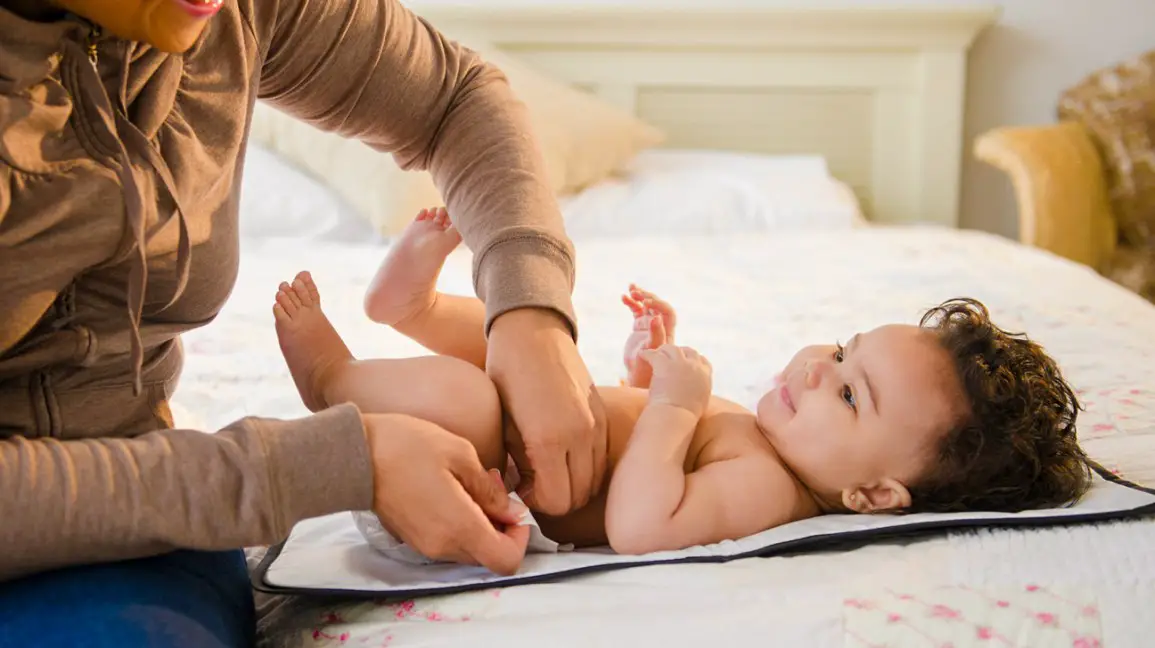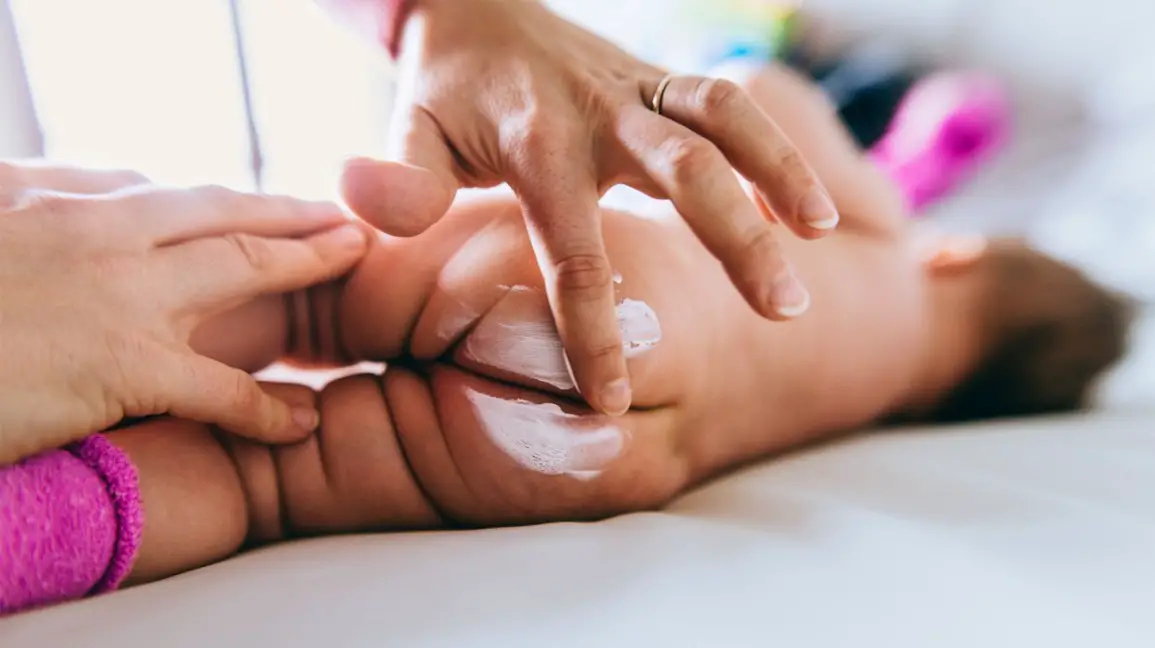Diaper rash, or diaper dermatitis, is one of the most common skin problems for babies and children, mostly affecting those between 4 and 15 months old.
More than half of babies of this age have diaper rashes at least once in two months.
Diaper rash can occur when the skin is exposed to moisture against the baby’s skin, causing red bumps or large inflamed areas around the baby’s bottom, skin folds, and under the diaper area.
Diaper rash can often be treated at home. However, if you suspect it may be infected, or your baby seems to be in pain, you should consult your pediatrician.
Although many remedies can be used to treat diaper rash, keeping your baby clean and dry is important for diaper rash prevention.
Not only is diaper rash caused by moisture, but if you add in sensitive skin and chafing as your baby is constantly wriggling around, it is no surprise that some irritation may be caused!
There are several types of diaper rashes, so don’t panic if you find that your baby’s bum is suddenly looking a little angry!
However, it is important to identify which type of diaper rash your baby has to ensure that you can correctly treat it.
Types of Diaper Rash:

- Irritant Contact Dermatitis – The most common type of diaper rashes. It presents as redness or swelling around the top of the diaper, on the legs, or bottom.
- Candida Dermatitis or Yeast Infection – Deep red in color, patches inside the diaper area, and folds of the thighs. Girls may have discharge from the vagina, and boys may have dry, red patches on the penis.
- Allergic Dermatitis– Less common, although easier to recognize as your baby will most likely have a rash anywhere that the diaper or any products used have touched the skin.
- Streptococcus– A type of bacterial infection that should be treated immediately. A very bright red rash around the anus, sometimes spreading to the genitals. You may even notice blood in your baby’s poo—possible fever.
- Staphylococcus – Another bacterial infection that should be treated soon after discovery. This diaper rash will show red, pus-filled bumps—possible fever.
Diaper Rash Treatments and Remedies:

There are various treatments for diaper rash, including at-home remedies or prescribed medication that can help to ease the symptoms and heal the skin.
You should try to avoid heavily fragranced products and always consult your doctor if you are unsure how to treat your baby.
Let’s go through some of the treatments below!
Regularly Changing Your Baby’s Diaper:
If you have discovered that your baby has a diaper rash, it is important to change dirty diapers as soon as they are soiled, keeping the area clean and dry.
There is often a debate over whether cloth diapers are better for your baby than disposable diapers. However, for health and comfort, there is no huge difference.
Any diaper still needs to be changed as soon as it is full.
You should clean the affected areas with warm water and a soft cloth and avoid any wipes or products that contain alcohol.
Try to pat the area dry rather than rubbing the affected skin as this could cause further irritation.
Diaper Free Time:
It is beneficial to give your baby some diaper-free time several times a day, every day, to allow the skin to breathe, dry out current rashes, or prevent any future irritation that could occur.
If you are concerned about accidents, lay a towel down beforehand or place your baby on a dry-wipe mat. You can even try removing the diaper whilst your baby is sleeping.
The more diaper-free time, the better!
Over the Counter Ointments Such as Desitin Diaper Rash Cream:
Over the counter, zinc oxide creams can be very effective in clearing up your baby’s diaper rash and can be applied throughout the day.
They are easy to obtain and do not require a prescription from a doctor.
They mainly provide a protective layer over the skin and soothe any soreness and irritation.
Products such as Desitin Daily Defence Cream provide relief for your baby and can reduce redness and irritation.
In one study, 90% of babies with diaper rash had noticeable relief within 12 hours of using Desitin Daily Defence Cream.
Until the rash has fully cleared, you should bathe your baby daily, using fragrance-free products, and apply the ointment when your baby is clean and dry.
Cornstarch for Diaper Rash:
For a long time, cornstarch, or any other type of baby powder, has been a go-to remedy for diaper rash due to its drying nature.
For rashes caused by excess moisture, cornstarch or similar products have been recommended as a way to absorb the moisture and reduce skin-on-skin friction.
However, this can only be effective depending on what is causing your baby’s rash, and it has been known to have adverse effects on certain types of diaper rash.
Many people have said that cornstarch can make a yeast infection worse.
Baking Soda for Diaper Rash:
Baking soda is said to have healing qualities, containing anti-inflammatory and antiseptic properties, and many parents swear by it.
Soaking clean washcloths in baking soda mixed with warm water or mixing baking soda in the bathwater to wash the baby’s rash can be a good way to soothe the raw and relieve symptoms.
This should always be done with caution, using minimal baking soda to avoid absorption through the baby’s skin.
Soaking for 10 minutes at a time is usually enough for most cases.
Coconut Oil for Diaper Rash:
Coconut oil has become increasingly popular in recent years. It can be used for some things, such as cooking, teeth whitening, moisturizing, hair conditioning, and many more.
As coconut oil is a natural product, it has often been recommended as a suitable treatment for diaper rash.
Coconut oil has been known to reduce redness and irritation on the skin.
However, this may not be true for all cases, and there isn’t any specific research that backs this.
Despite this, researchers have found that coconut oil can help promote wound healing, moisturize the skin, and provide a protective barrier, and provide some relief for your baby.
![]() When To See A Doctor:
When To See A Doctor:
Diaper rash can often look a lot worse than it is, and in most circumstances, your baby won’t be affected by the irritation.
However, certain cases will need to be looked over by the pediatrician, who may want to prescribe antibiotics.
If you suspect that your baby’s diaper rash may be infected, book an appointment as soon as you can.
Signs of infection to look out for include!
- Fever.
- Blisters.
- Pus or discharge.
- Persistent or severe redness.
- No signs of healing after a few days.
- Signs that your baby is in pain.

As a mother of four very energetic children, Emilia knows how chaotic motherhood can be. She’s learned a lot of lessons along the journey so far and loves sharing the tips & tricks she’s picked up over the years with anybody else on the same life path.

